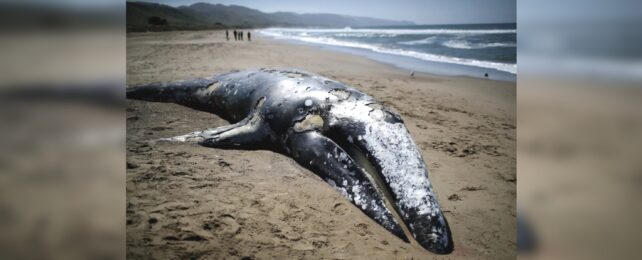Gray whales have been washing up dead on the Pacific coast at an alarming rate since 2019, and scientists think they might finally know why.
The gray whale strandings from Mexico all the way to Alaska have been declared an "unusual mortality event," or a significant die-off of a species that is unexplained and requires a quick response.
Two other mass die-offs of gray whales occurred in the 1980s and 1990s, though those only lasted a couple of years; the latest is still ongoing.
The latest die-off has caused the North Pacific gray whale population to plummet from an estimated 27,000 in 2016 to 14,500 in 2023, according to the National Oceanic and Atmospheric Administration.
For years, researchers could only guess what was killing the whales. NOAA has previously noted that emaciation had been observed in some of the dead whales, but not in others.
But scientists at Oregon State University's Marine Mammal Institute now say there is strong evidence that the whale deaths are linked directly to sea ice melting in the Arctic, according to a study published Thursday in the journal Science.
Joshua Stewart, an assistant professor at the Marine Mammal Institute and lead author of the study, said the decrease in sea ice was also causing the gray whales' food supply to diminish.
"Feels like this time we've got a pretty good 'smoking gun'," Stewart told the outlet KTVB of the explanation of what was causing the whale deaths.
Gray whales make the longest migration of any mammal on Earth, traveling more than 12,000 miles every year from their foraging grounds in the Arctic, where they spend the summers, to their breeding grounds in the warm, shallow lagoons of Mexico's Baja Peninsula, where they spend the winters.
While in the Arctic, the gray whales feed on amphipod crustaceans. Amphipods in turn feed on algae, which grows on the underside of sea ice.
"With less ice, you get less algae, which is worse for the gray whale prey," Stewart said in a release from Oregon State, adding, "When there are sudden declines in the quality of prey, the population of gray whales is significantly affected."
In other words, the melting sea ice disrupts the entire food chain.
The decrease in available food can cause skinnier or malnourished whales, as well as lower birth rates. Stewart said he does not think there is currently a risk of extinction for gray whales.
The species, which was hunted to the brink of extinction decades ago, has been touted as a major conservation success thanks to the populations bouncing back after international whaling regulations were enacted.
But the die-offs are a reminder of the wide-ranging impacts of the climate crisis, as sea ice continues to melt at alarming and historic rates.
"Even highly mobile, long-lived species such as gray whales are sensitive to climate change impacts," Stewart said.
And while he said we probably do not have to worry about extinction, we may have to simply get used to having fewer gray whales.
This article was originally published by Business Insider.
More from Business Insider: